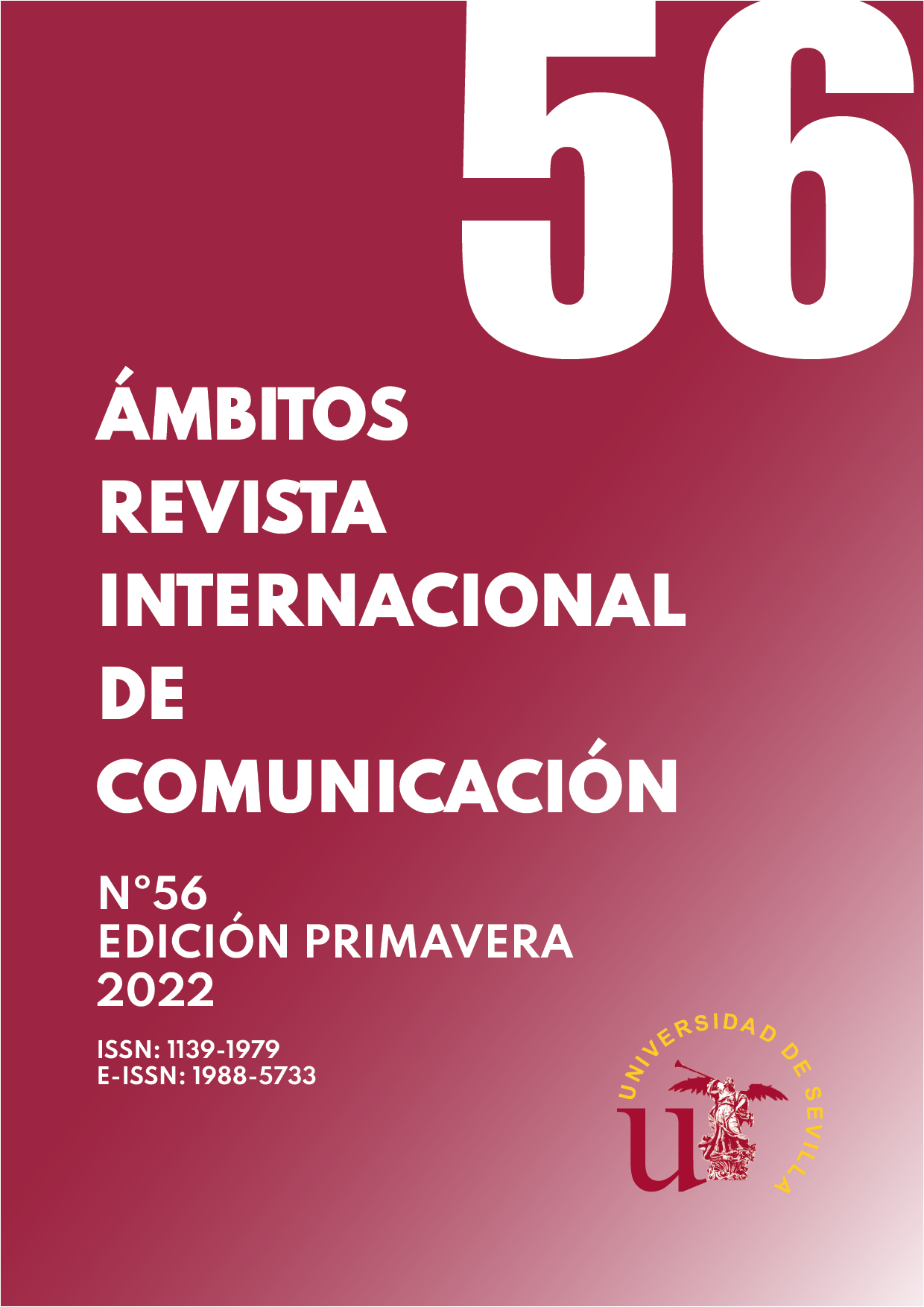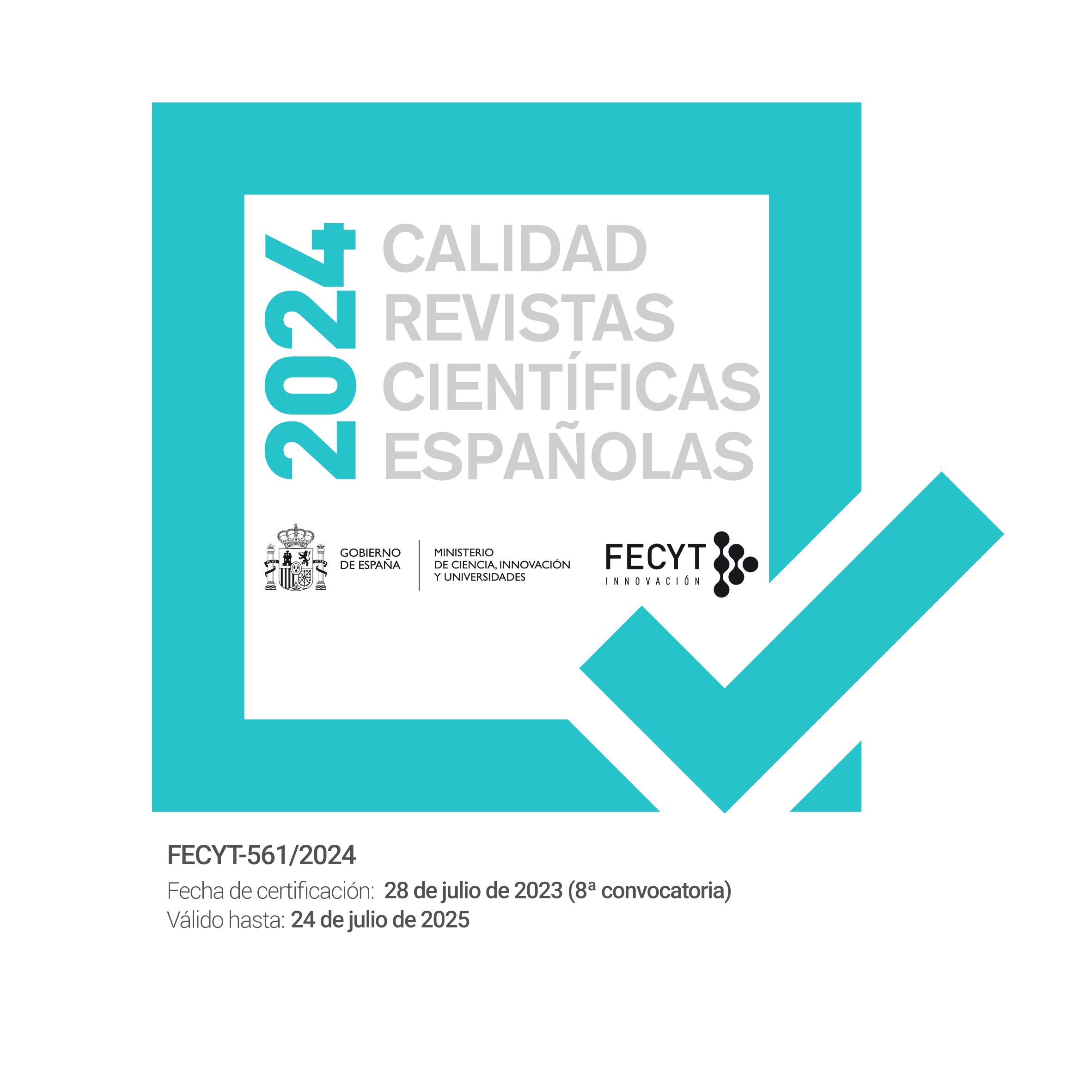Frames del final del terrorismo de ETA. Análisis argumentativo de cuatro editoriales españoles (4 de mayo de 2018)
DOI:
https://doi.org/10.12795/Ambitos.2022.i56.11Palabras clave:
argumentación, framing, editorial, ETA, terrorismoResumen
En este estudio se pretende explorar la base ideológica y las estrategias argumentativas desplegadas en los editoriales de cuatro periódicos españoles (El Mundo, El País, La Vanguardia y El Periódico), del 4 mayo 2018, fecha de la publicación de la noticia del fin de la banda terrorista ETA. El análisis discursivo y argumentativo de estos editoriales se basa en un método híbrido -al que se le han incorporado nuevas categorías en este estudio- resultado de la combinación de algunos principios del Análisis del Discurso y de la Lingüística del Texto, así como del Framing. En un nivel macro-estructural se explora la progresión argumentativa de texto (Amossy, 2006; 2009) y las metáforas conceptuales, y en otro nivel micro-estructural se analizan ciertos aspectos de la cohesión textual y de la argumentación, además de los frames.
Como consecuencia de este análisis, se descubre la función destacada del «relato» en los editoriales de El Mundo y El País, el papel de las víctimas en el conjunto de los textos periodísticos estudiados, e incluso un posicionamiento diferente ante los presos etarras.
Mientras que El Mundo y El País pretenden desarmar las mentiras de ETA, buscando conservar la memoria de la verdad de lo ocurrido, en el editorial de La Vanguardia se legitiman, veladamente, las pretensiones del grupo terrorista, e incluso queda desdibujada en el texto de El Periódico la crítica al relato de los terroristas por querer darles voz a todos los actores.
Las estrategias argumentativas, los elementos de frame y las metáforas conceptuales del dominio espectáculo (El Mundo y El País) y del dominio guerra (La Vanguardia y El Periódico) trasladan el estilo decidido de El Mundo, el tono contundente de El País, y la moderación de La Vanguardia y de El Periódico.
Descargas
Citas
Alonso, R. (2018). La derrota del vencedor: El final del terrorismo de ETA. Alianza Editorial.
Amossy, R. (2006). L’argumentation dans le discours. Armand Colin.
Amossy, R. (2009). Argumentation in Discourse: A Socio-discursive Approach to Arguments. Informal Logic, vol. 29(3), pp. 252-267. https://doi.org/10.22329/il.v29i3.2843
Aurell, J. (2012). La formación de un gran relato sobre el Opus Dei. Studia et Documenta: rivista dell’Istituto Storico San Josemaría Escrivá, 6, 235-294.
Azurmendi, M. (2017). El relato vasco. Libros para entender el fin de ETA. Almuzara.
Beer, F.A. y Ch. de Landtsheer (eds.) (2004). Metaphorical World Politics. University Press East Lansing.
Breeze, R. (2013). British media discourses on the wearing of religious symbols. Belle, H. Van, Gillaerts, P., Gorp, B. van, Mieroop. Verbal and visual rhetoric in a media world. Leiden University Press, 197-211.
Calleja, J. M.ª (2014). El terrorismo, visto desde la Psicología y la Comunicación. Revista de análisis transaccional y psicología humanista, 71, 53-66.
Caminos-Marcet, J. M., Armentia-Vizuete, J. I., y Marín-Murillo, M. F. (2013). Los diarios vascos frente al terrorismo (1990, 2000, 2008 y 2009). Análisis de los editoriales sobre los atentados mortales de ETA. Revista Latina de Comunicación Social, 68, 1-16. 10.4185/RLCS-2013-967
Caminos-Marcet, J. M., Armentia-Vizuete, J. I. y Marín-Murillo, F. (2013b). El asesinato de Miguel Ángel Blanco como ejemplo de key event en el tratamiento mediático de los atentados mortales de ETA. adComunica. Revista Científica de Estrategias, Tendencias e Innovación en Comunicación, nº 6, pp. 139-160. http://dx.doi.org/10.6035/2174-0992.2013.6.9
Canel Crespo, M.ª J. (1999). El País, ABC y El Mundo: tres manchetas, tres enfoques de las noticias. ZER Revista de Estudios de Comunicación, 6, 97-117.
Coca, C. (2005). La evolución del tratamiento del terrorismo en España. Medios irreconocibles, Revista Telos, 63, pp. 1-6.https://telos.fundaciontelefonica.com/archivo/numero063/
Contreras, D. (2022). Reseña de «Con la religión hemos dado, Sancho. Framing de la religión en editoriales de cuatro periódicos españoles». Discurso & Sociedad, 16, 2 (en prensa).
Díaz-Cerveró, E. (2009). La representación del terrorismo de ETA en el diario francés Le Monde. DOXA Comunicación, 9 ,165-189.
https://revistascientificas.uspceu.com/doxacomunicacion/article/view/1200
Domínguez, N. (2007). Conectores discursivos en textos argumentativos breves. Arco/Libros.
El Mundo (2018, 4 de mayo). La memoria de las víctimas es nuestra dignidad. Editorial.
https://www.elmundo.es/opinion/2018/05/04/5aeb4e2c468aeb744a8b45b2.html
El País (2018, 4 de mayo). ETA no nos engaña. Editorial.
https://elpais.com/elpais/2018/05/03/opinion/1525372079_812341.html
El Periódico (2018, 4 de mayo). ETA certifica su derrota. Editorial.
https://www.elperiodico.com/es/opinion/20180504/eta-certifica-su-derrota-6800805
Entman, R. M. (1993). Framing: Toward clarification of a fractured paradigm. Journal of Communication, 43(4), 51-58. https://doi.org/10.1111/j.1460-2466.1993.tb01304.x
Fernández Soldevilla, G. (2016). La voluntad del “gudari”: génesis y metástasis de la violencia de ETA. Tecnos.
Fernández Soldevilla, G. (2020). ¿Crímenes ejemplares? Prensa, propaganda e historia ante las primeras muertes de ETA. Sancho el sabio: Revista de cultura e investigación vasca, 43, 49-71.
Foix, L. (2016). Aquella porta giratòria. Destino.
Franco, A. (2003). Por una información responsable. Terrorismo, víctimas y medios de comunicación. Fundación Víctimas del Terrorismo, 43-46.
Giró, X. (1999). Análisis crítico del discurso sobre nacionalismo e identidad en los editoriales de la prensa diaria publicada en Cataluña desde la transición hasta el gobierno del PP (1977-1996). [Tesis doctoral, Universitat Autónoma de Barcelona].
Grijelmo, A. (2000). La seducción de las palabras. Taurus.
Institute for Economics y Peace (2020). Índice Global del Terrorismo. IEP.
Halliday, M. A. K. y Hasan, R. (1989). Language, Context, and Text: Aspects of Language in a Social-Semiotic Perspective. Oxford University Press, 2nd ed.
Hernández Valls, F. (2017). Terrorismo y propaganda en los medios de comunicación. El final de ETA a través de la prensa. [Tesis doctoral, Universidad Complutense de Madrid]. https://eprints.ucm.es/id/eprint/41932/
Herrero, M., Artero, J.P. y Sánchez-Tabernero A. (2009). Los contenidos editoriales como herramienta determinante para construir una marca: el caso de El Mundo. DOXA Comunicación, n.º 8, pp. 163-182. http://goo.gl/OsHGQX
Idoyaga, P. y T. Ramírez-de-la-Piscina (2001). Política informativa de El País y ABC ante la nueva situación política del País Vasco (1998-2000). Zer. Revista de estudios de comunicación, 10, 257-279. https://doi.org/10.1387/zer.6116
Jiménez, R.-M. (2014). Metadiscurso y persuasión: estudio de editoriales de periódicos españoles sobre la muerte de Osama bin Laden. Discurso & Sociedad, 4, 589-622. http://www.dissoc.org/ediciones/v08n04/DS8(4)Jimenez.html
Jiménez-Yáñez, R.-M. (2019). Análisis de los editoriales sobre una polémica visita papal. Onomázein, 44, 63-84. DOI: 10.7764/onomazein.44.04
Jiménez-Yáñez, R.-M. y R. Breeze (2020): Eleven eventful days in Cataluña: metaphor scenarios in the media. In Breeze, R. y C. Llamas Saíz (eds.) Metaphor in Political Conflict. Populism and Discourse. Eunsa, 177-208.
Jiménez-Yáñez, R.-M. (2021): Con la religión hemos dado, Sancho. Framing de la religión en editoriales de prensa de cuatro periódicos españoles. Fragua.
La Vanguardia (2001). Estatuto de redacción de La Vanguardia. https://sindicatperiodistes.cat/es/la-vanguardia/
La Vanguardia (2018, 4 de mayo). ) La disolución de ETA. Editorial.
Lázaro, F. (2003). La información en prensa, Terrorismo, víctimas y medios de comunicación. Fundación Víctimas del Terrorismo, 63-78.
McLuhan, M. (1978, 16 febrero). Il Tempo.
Merodio, I. (2010). Análisis de editoriales e informaciones sobre el Plan Ibarretxe en la prensa generalista española de 2001 a 2006. [Tesis doctoral, Universidad del País Vasco].
Miguel, A. y Moreno, M. Á. (2015). ¿Cese definitivo de la actividad armada o fin del terror? La declaración del fin de la violencia de ETA en la portada de los diarios españoles. Estudios sobre el Mensaje Periodístico. 21(2), 11111128.
Moragas-Fernández, C., Montagut M. y A. Capdevila (2018). The process en route: the metaphor of the journey as the dominant narrative for the political discourse in Catalonia. Critical Discourse Studies, 15(5), 517-539. https://doi.org/10.1080/17405904.2018.1468787
Moreno Espinosa, P. (2002). Géneros para la persuasión en prensa: los editoriales del diario El País. Ámbitos, Revista internacional de comunicación, 9-10, 225-238. https://revistascientificas.us.es/index.php/Ambitos/article/view/9498
Morera Hernández, C. (2021). La representación de ETA en la prensa española: el terrorismo en portada (1973-1998). Revista General de Información y Documentación, 31(2), 735-755. https://doi.org/10.5209/rgid.79466
Pinero-Pinero, G. (2018). Metáfora conceptual y el marco ESPECTÁCULO en el discurso político de los medios de comunicación. Ibérica, 36, 119-142.
Rivas Troitiño, J. M. (2001). La actitud de beligerancia frente al terrorismo. Estudios sobre el Mensaje Periodístico, 7, 271. https://revistas.ucm.es/index.php/ESMP/article/view/ESMP0101110271A
Rodrigo-Alsina, M. (2001). Los medios de comunicación ante el terrorismo. Icaria.
Shoshani, A. y M. Slone (2008). The Drama of Media Coverage of Terrorism: Emotional and Attitudinal Impact on the Audience. Studies in Conflict & Terrorism, 31(7), 627-640. https://doi.org/10.1080/10576100802144064
Soria, C. (1997). El laberinto informativo: una salida ética. EUNSA.
Soria, C. (2001). Estrategias para combatir el terrorismo desde la Comunicación Política y la Comunicación Informativa. Palabra Clave, 5, 1-12. https://palabraclave.unisabana.edu.co/index.php/palabraclave/issue/view/35
Van Dijk, T. (2015). Cincuenta años de estudios del discurso. Discurso & Sociedad, 9(1-2), 15-32.
Veres, L. (2004). Persuasión lingüística, terrorismo y prensa escrita. El Argonauta español, 1. https://doi.org/10.4000/argonauta.1151
Veres, L. (2006). La retórica del terror. Sobre lenguaje, terrorismo y medios de comunicación. Ediciones de la Torre.
Veres, L. (2011). Iconos, terrorismo y comunicación. El Argonauta español, 8. https://doi.org/10.4000/argonauta.223.
Wieviorka, M. y D. Wolton (1987). Terrorisme à la une. Média, terrorisme et démocratie. Gallimard.
Descargas
Publicado
Cómo citar
Número
Sección
Licencia
Derechos de autor 2022 Ricardo-María Jiménez-Yáñez

Esta obra está bajo una licencia internacional Creative Commons Atribución-NoComercial-CompartirIgual 4.0.
Ámbitos. Revista Internacional de Comunicación es una revista de acceso abierto, lo que significa que todo su contenido está disponible gratuitamente para el usuario o su institución. Los usuarios pueden leer, descargar, copiar, distribuir, imprimir, buscar o enlazar con el texto completo de los artículos, o utilizarlos para cualquier otro fin lícito, sin solicitar permiso previo al editor o al autor. Esta definición de acceso abierto se ajusta a la Iniciativa de Acceso Abierto de Budapest (BOAI).

A menos que se indique lo contrario, todo el contenido de la edición electrónica se distribuye bajo una " licencia internacional Creative Commons Attribution-NonCommercial-ShareAlike 4.0 ". Puede consultar la versión informativa y el texto legal de la licencia aquí. Esto debe indicarse expresamente de esta manera cuando sea necesario.
En caso de aceptación del manuscrito, los autores ceden los derechos de la obra para su publicación a Ámbitos. Revista Internacional de Comunicación bajo el contrato de licencia Reconocimiento-NoComercial-CompartirIgual 4.0 Internacional (CC BY-NC-SA 4.0). Los autores conservan los derechos de autor y terceros están autorizados a copiar, distribuir y hacer uso de la obra, siempre que cumplan con los términos y condiciones establecidos en la licencia.
- Citar la autoría y la fuente original de publicación (revista, editorial y URL de la obra).
- No los utilice con fines comerciales.
- Si remezcla, transforma o crea a partir del material, debe publicar sus contribuciones bajo la misma licencia que el original.
Se puede encontrar más información en https://creativecommons.org/licenses/by-nc-sa/4.0/deed.es



















